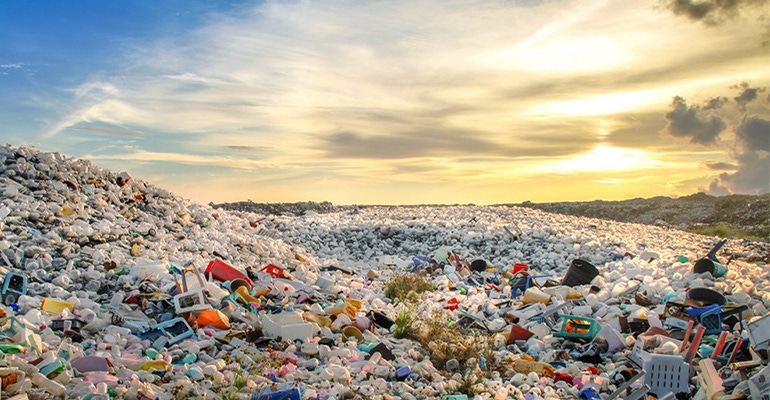Grappling with Sustainability: Chemical and Plastic Challenges
With plastics’ future tied to the chemicals industry, what are the ongoing drivers and challenges that affect both?

As the world moves along the path to a zero-carbon future, the chemical industry, along with all other industrial sectors, is under heightened pressure to hasten its transition. For the sector sustainability is not a new challenge; for decades companies have worked under increasingly stringent regulations. The spotlight is now shining brightly on chemical companies and their impact on climate change, global food supply shortages and how to deal with plastic waste. But what are the actual drivers for sustainable transformation in the chemicals industry?
There are four significant drivers for sustainable transformation, in order of importance they are emissions, increasing regulations, ethical and green based investments, and greater circularity of resources.
End-user demand is the weightiest driver as many consumer goods companies are pushing for change, increasingly demanding reductions in their emissions footprint throughout the entire value chain.
1. Measuring up when it comes to emissions.
Companies are increasingly looking beyond their scope 1 and 2 emissions under Greenhouse Gas (GHG) Protocol Corporate Standard. These classify a company's GHG emissions into three "scopes":
Scope 1 emissions are direct emissions from owned or controlled sources.
Scope 2 emissions are indirect emissions from the generation of purchased energy.
Scope 3 emissions are all indirect emissions, not included in Scope 2, that occur in the value chain of the reporting company, including both upstream and downstream.
They are demanding measurement of emissions and that is causing a certain amount of angst all the way back through the supply chain. However, what some companies view as an onerous task is viewed by more enterprising businesses as an opportunity. There are many that have driven sustainability into the core of the company’s DNA to form the heart of their strategy. They view it as a way to differentiate themselves in the marketplace, gain first mover advantage, gain market share, and ultimately as a way of setting themselves up for long-term success. For now, the demand for low footprint, eco-friendly products are outweighing supply. Most of the providers that are active in the market now can command a hefty premium. It is likely that this is going to go down as more and more companies transform their processes.
2. Increasing regulatory burden.
The second driver is regulation. Currently this lags end-user demand, but it will grow and eventually outpace it as the main driver for change. The number of climate laws has grown exponentially over the past few years and many nations are now making binding commitments to achieve net zero carbon emissions. Many of the countries have set a target of 2025 but some are stretching it a bit further. At the last count there were 131 countries that have committed to achieving that net zero status although to date only eight of those have it enshrined in law.
The race to zero carbon is not the only regulatory burden that chemical companies are facing, there will be more legislation coming down the road in rapid succession. There is regulation around carbon emissions in the guise of cap-and-trade schemes in the EU and parts of the US. Outside of those you have increasing likelihood of taxation.
A fascinating issue that the industry is wrestling with is how to price emissions of carbon over the coming years. Certainly, our carbon analytics team forecasts carbon dioxide prices under the EU Emission Trading Scheme (ETS). The ETS is the world’s biggest greenhouse gas trading programme. It was launched in 2005 and is a key pillar of the EU’s fight against global warming and CO2 emissions. Our analysts have many scenarios for carbon pricing, and they are increasingly bullish. A significant challenge for many chemicals companies is how to build in the higher price scenarios into their decision making.
Another legislative change is the EU Green Deal and the raft of legislation that is coming out of Brussels. As part of this, in October the European Commission adopted the EU Chemicals Strategy for Sustainability. The strategy is the first step towards a zero-pollution ambition for a toxic-free environment announced in the European Green Deal. The aim is to boost innovation for safe and sustainable chemicals and increase protection of human health and the environment against hazardous chemicals. The strategy will prohibit the use of the most harmful chemicals in consumer products such as toys, childcare articles, cosmetics, detergents, food-contact materials and textiles unless proven essential for society and ensuring that all chemicals are used more safely and sustainably.
Then there is the looming upheaval that will surround the introduction of the Non-Financial Reporting Directive (NFRD). The European Commission has adopted non-binding guidelines on the disclosure of non-financial information by companies. Their objective is to help companies fulfil the requirement to disclose relevant and useful information on environmental and social matters in a consistent and more comparable way. The changes here may sound quite prosaic, but it is the EU taxonomy around this disclosure that will have a significant impact on the industry. These changes will be coming into force next year and investors will be coming back to corporates and industry to demand increasingly rigorous measurements around that taxonomy.
3. Facing the funding conundrum.
The final driver is the surge in Environmental, Social and Governance (ESG) investment and I do not think this is simply a short-term trend that will disappear. ESG investing refers to a class of investing that is also known as sustainable investing. This is an umbrella term for investments that seek positive returns and long-term impact on society, environment, and the performance of the business.
I have heard that described recently as a flight to quality, and certainly the performance of many of these funds during COVID-19 seems to bear that out. Related to that finance is the increasing likelihood that interest rates are going to rise from any borrowing where a business cannot prove that it is a sustainable business. We should not underestimate the level of challenge for the chemicals industry. Although the sector is not as high emitting as iron and steel, and cement, the transformation will still have to be dramatic, and there will certainly be winners and losers as this happens.
4. The need for circularity.
But it is not just reducing emission where end-user demand is shaping the future of the industry. When it comes to plastics, and especially plastic bottles, one of the primary demands is that a greater proportion of the plastic waste is recycled and a key strategy here is circularity. The circular economy is an economic system in which materials are designed to be used, not used up. From the outset, products, and the systems they sit within should be designed to ensure no materials are lost, no toxins are leaked, and the maximum use is achieved from every process, material, and component.
Everyone is aware of the issue of plastic waste and how it has climbed agendas, but also as a solution to the bigger question around emissions and emissions intensity. The problem of plastic waste is a large-scale dilemma particularly given the poor recycling rates across Europe, Asia, and the US. There are extremely restricted options for recycling, it is limited to mechanical recycling, which is converting plastic through sorting, washing and reconstitution back to plastic.
The average plant size is still quite small, and it is a very fragmented industry with extremely low yield according to the data we have gathered this year. One of the main causes of low yields, and in fact, low recycling rates in general is the quality of waste feedstock, but also lower volumes collected this year due to the pandemic. Waste collection and sorting infrastructure is the main barrier to the growth in recycling rates, but the sector has also been beset by lower crude oil prices that has fed into a lower price for petrochemicals and virgin plastics this year, causing some sectors within recycling to struggle financially as they compete with the lower virgin plastics prices. Some segments have been immune to this, particularly the higher-grade material that is demanded by the fast-moving consumer goods brands that has a startling premium over virgin PET. This will continue because of the supply demand balance in the market. Some European recyclers that can produce this high-quality food grade material are sold out several years ahead, while some of the lower quality recycled plastics struggle.
It is hoped that this disparity can be solved by the relatively new industry of chemical recycling, which some people call molecular recycling or advanced recycling. In this process the waste plastic is broken back down into a monomer or a fuel and oil substance and rather than plastic back to plastic it can go back through the process of polymer manufacture. One drawback here is that there is little transparency around the environmental impact, with limited lifecycle assessments released publicly.
For this technology to have a significant impact its needs to scale up and move away from small regional recycling centres to larger plants. It is also not known yet how regulators are going to treat this material and class it as recycled plastic. This is crucial as it will allow sellers and buyers to benefit from all the tax relief available. On the plus side, some of these processes can take mixed plastic waste that is hard to recycle mechanically, although it should be said, some of the processes still need a high degree of sorting. The output quality is a big plus here which means that these products can be infinitely recycled, unlike mechanically recycled plastic, where the quality eventually degrades over time. Whatever route the industry takes, circularity will become ever more important as we move towards the low-carbon future.
Helen McGeough, Senior Analyst, Plastics Recycling, Independent Commodity Intelligence Services, leads market analysis and consulting for global recycled PET markets, working with contacts across the supply chain from collection, reclamation through to end users. She has 20+ years’ experience in consultancy, having worked initially in the Digital Technology industry and for the past 15 years in recycled PET within ICIS and Wood Mackenzie (previously PCI).
About the Author(s)
You May Also Like




